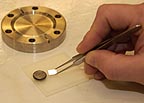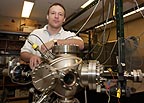April 17, 2006
SIUC scientist receives $480,000 grant from NSF
CARBONDALE, Ill. -- Imagine a computer that doesn't need to "boot up" when you turn it on. It's ready to use as soon as you flip the switch and has a memory system that doesn't require a constant source of power and would remain intact even if you turn it off without saving your work.
A scientist in Southern Illinois University Carbondale's College of Science is working on materials that could make that and many other new advances in electronics possible.
Shane Stadler, an assistant professor of physics, recently received a $480,000 CAREER grant from the National Science Foundation to study ways to "grow" the materials that would make this possible. Known as "half-metallic alloys," such substances could open a new field of study and product design based on a concept known as "spintronics."
The term derives its names from a property electrons possess called "spin." The tiny particles, which make up parts of an atom, typically possess the spin property in one of two directions, which scientists sometimes term "spin up" or "spin down."
Stadler's research focuses on ways to exploit and harness this inherent sub-atomic difference.
Where a normal electrical conductor, such as a copper wire, allows the flow of both kinds of electrons, the half-metallic material Stadler is working on essentially filters the current so that only one kind – either up or down spin – flows. Such a material could lead to the development of a spin-polarized magnetic transistor, which would control the "filtered" current.
Developers could put such transistors to use in a host of new products, including a magnetic random access memory that is more stable than those currently used in computers and does not require a boot up. It also could make possible a new generation of sensors and theoretically would require less electricity to operate, making it ideal for use in space, where energy consumption is an issue.
"The development of a near perfect half-metallic material would spark the development of electronic devices and components that exploit the spin property of the electron," said Stadler, a 37-year-old Wisconsin native who arrived at SIUC in 2001 after doing post-doctoral research on magnetized materials at the U.S. Naval Research Laboratory. "This could revolutionize the field of electronics as we know it today."
A main thrust of Stadler's work involves finding the best method of "growing" high quality half-metallic, ultra-thin alloy films that filter electrons most efficiently.
Simply using heat to evaporate the alloy for deposit onto a piece of silicon doesn't work well because of the many imperfections that result. Instead, Stadler's work, which is taking shape in one of the many laboratories at SIUC's Neckers Building, takes place in an envelope of extremes, including ultra-high vacuums, powerful lasers and alloys of precise composition and structure.
Typically, the process begins with a fingernail-sized "target" made of a cobalt-manganese-silicon alloy, which is placed in an extreme vacuum that provides a clean environment. The researcher next fires an ultraviolet pulse laser at the target, essentially blasting proportional amounts of each substance into a plume, which subsequently deposits them in a thin film on an adjacent piece of silicon.
During this process, some of Stadler's work will revolve around finding the best recipe by experimenting with variables such as applying a magnetic field and changing the temperature.
"I've got a lot of work cut out for me," Stadler said.
Stadler's five-year grant is part of the foundation's Faculty Early Career Development Program aimed at supporting the early research and education activities of teachers who effectively integrate research and education within the context of their organization's mission.
Along with equipment upgrades, the grant also will pay for nine graduate students who will be among the first to receive doctoral degrees in applied physics from SIUC. The grant also will pay for a new, innovative undergraduate course on magnetism and research methods. Stadler said the future of such technology not only rests with conducting the pure science such as his own research, but recruiting and training many young scientists to explore the field.
Leading in research, scholarly and creative activities is among the goals of Southern at 150: Building Excellence Through Commitment, the blueprint the University is following as it approaches its 150th anniversary in 2019.

From target to film – Shane
Stadler, assistant professo
r in the Department of
Physics at Southern Illinois
University Carbondale,
uses tweezers to hold a
cobalt-magnesium-silicon
film created by firing
an ultraviolet pulse lase
r into the target alloy at
left. Stadler recently
received a $480,000 grant
from the National Science
Foundation to study ways
of creating films that
“filter” certain kinds of
electrons and could
revolutionize electronics.
Download Photo Here

Electronics revolution – Shane
Stadler, assistant professor
in the Department of Physics
at Southern Illinois University
Carbondale, demonstrates a
vacuum chamber in a laboratory.
Stadler uses a nearby
ultraviolet pulse laser to
blast a cobalt-magnesium-silicon
alloy and create extremely
thin films of the material as
part of his research recently
funded by the National Science
Foundation. The ultra-high
vacuum created in the chamber
creates an extremely clean
environment in which to create
the films. Download
Photo Here
